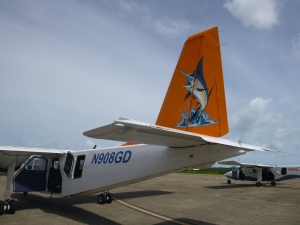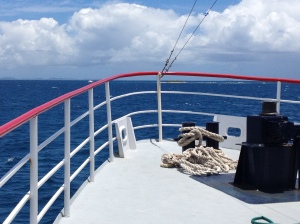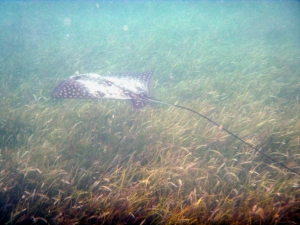It just doesn’t make any sense to go to Puerto Rico and skip the mofongo. Mashed fried plantains with bacon is your national dish? Sign me up!
Or so I thought.
Midway through our trip to Vieques over Memorial Day week this year we went up to Isabel Segunda for dinner. Man, is that town dead at night in the offseason—you might see someone riding around on a horse, but then again, you might not. We had already been up there once for dinner at Coqui Fire, but we were ready for some Puerto Rican food. We drove around looking for someplace that was actually open and finally went to Sabores (or Biekes Bistro, I can’t remember which).
Was the food good? Sure…we tried a variety, some fish, some chicken, some beef. I had skirt steak and mofongo and it was amazing that I actually survived the experience. Mofongo may be the heaviest thing that a human being can ingest and live. I almost couldn’t climb into the Jeep. Upon arrival at the rental house I went into the bedroom and groaned. The other person who had mofongo did the same.
You’re thinking, “Well, what did you expect? It’s fried plantain with bacon.” But people eat it daily! How do they survive? It’s a hot climate!
Anyway, on to the trip report.
Getting There, Getting Around
This was our first time in Puerto Rico, but I’m sure it won’t be our last. To get to Vieques or Culebra, its sister island, you need to take a small plane or the ferry. The ferries are supposedly incredibly unreliable and when we were booking the trip I was feeling fairly prosperous, so I booked us on the 15 minute flight from Ceiba airport. It’s about 45 minutes from San Juan, so we took an $80 cab ride down there, passing through areas that looked oddly like Queens but with palm trees (which makes sense when you think about it).
We had some time to kill so we hung around outside looking at birds and chilling with an island dog. I’m always a little ambivalent about island dogs—on one hand, every dog deserves to be loved, cherished, and cared for. On the other, they get to keep their balls, live on an island, and chase crabs. One of our first discoveries on this trip was that even an emaciated island dog hanging around the airport parking lot will turn its nose up at a Twizzler. Hmm, may need to rethink our airplane snack of choice.
The plane is incredibly small and there’s a strict 25 pound weight limit on baggage. They even weigh you on the baggage scale to make sure you didn’t lie when you booked your tickets and to balance the load. We’re turning into small plane connoissuers and this one was a gem:
We picked up our Jeep on arrival and you definitely need one on Vieques. The main roads are great, but getting to the good beaches is a little bit of an adventure even with high clearance and four wheel drive.
On the way back we took the ferry to Fajardo: cheap, scenic, pretty much on time. But we did the gringo thing (of course) and sat outside for the views, and the brand new eyeglasses inside my knapsack actually melted in the sun.
Where We Stayed
Vieques has two towns, Isabel Segunda and Esperanza. Isabel Segunda is larger and has more services: the ferry, the fisherman’s market, government offices. Esperanza on the other hand has the Malecon and tourist-oriented conveniences. We stayed at Casa Anolis in Esperanza and it was a great value: three bedrooms with absolutely essential air conditioning, a totally adequate kitchen, a great back porch with a view of the ocean, and lots of fruit trees in the yard. It also had a huge shower with water pressure that knocked you backwards, plenty of towels, and laundry on the porch (very useful when you’re limited to 25 pounds and bringing a laptop and snorkel gear). It was a good choice.
Food and Drink
Mofongo aside, Vieques is great for chow. There are food trucks on the road toward the beaches during offseason weekends and you can get great, reasonably priced empanadas (fish, shrimp, chicken, crab, conch) and pinchos (pork, chicken, shrimp).
We had a pretty great time at the grocery stores, too. We didn’t do a lot of cooking—one big breakfast, one dinner—but we did a lot of snacking and drinking. Of all of the island grocery stores we’ve shopped, nothing beats the great big Plaza Extra on St. Croix. It’s as big as a Costco! But the Morales supermarkets on Vieques are just fine, with good selections of booze and mixers, Goya wafer cookies, and fairly reasonably priced sunscreen.
Another thing Vieques does well is the fisherman’s market in Isabel Segunda. It’s a central location for buying fresh fish and lobster. There’s no heading to the beach and haggling with individual fisherman, you just show up in late morning and point at what you want. And it’s in a pretty spot:
Another crazy thing about Puerto Rico is the Gasolinas—little cocktail pouches like juice boxes for grown-ups. We found one in the freezer when we got there and there’s one in our freezer right now.
Beaches and Snorkeling
Vieques is the only island in the Caribbean on which huge tracts of land are closed to the public due to unexploded ordnance. That’s right—for 63 years the U.S. Navy used it as a bombing range and over 8,000 acres are still closed because there are bombs laying around. While it means that this land is going to be preserved forever because it belongs to the U.S. Fish and Wildlife Service, it’s appalling for the economic and physical health of the local population. They have elevated cancer rates (perhaps due to the depleted uranium in the shells) and the environmental disaster is no doubt affecting the tourist numbers.
Perhaps the best beach on the island, La Chiva (Blue Beach), is closed for at least six months because they’ve found unexploded bombs in and around the little cayo just offshore. This was a big disappointment, but we did hit a variety of other beaches: Sombe (or Sun Bay), Caracas (Red Beach), Navio, Media Luna, Punta Arenas (Green Beach), and the Rompeolas (the old Navy pier on the north side of the island).
Over time my standards for beaches have changed. I used to boogie board. I wanted surf. I’ve changed, and now I want to snorkel in calm, clear water. Most of the beaches on Vieques were a little rough and very cloudy (and we found a Portuguese Man O’War washed up on Navio and promptly left). That doesn’t mean that they weren’t fun and great, but we’ve turned into snorkeling snobs and the snorkeling on Vieques simply isn’t up to the standards of the U.S. Virgin Islands. That being said, I crossed a big one off my list:
And Buck both a) saw and b) documented a hawksbill turtle hiding under a ledge at Punta Arenas:
Adventures and Wildlife
We went to Vieques in large part for the bioluminescent bay and for a while we thought it might not happen. Formerly the most consistently bright bio bay in the world, Mosquito Bay went dark this winter. The jury’s still out on what caused it: unusually high tides, salinity, pH, runoff, or other human factors. Regardless, it’s a nightmare for the island. There’s graffiti everywhere saying “Save the Bay.” Tour sizes are now cut by 50%, and for now tours are available only on Friday, Saturday, and Sunday. They’re finally enforcing the rules about not swimming in the bay (which would be amazing, but sometimes you have to have less fun to avoid killing the things you love) but we found that they didn’t enforce the prohibition against bug spray. We didn’t do it, but people in our group were spraying down like crazy at the edge of the bay.
We set out on Sunday night down the incredibly bumpy road in an enormous van, which promptly got stuck in the muddy lot next to the bay. We hopped into two-man kayaks and spent around an hour.
If this is what the bay is like when it’s dark, I’m really sad we didn’t go a couple of years ago. Here’s what they don’t tell you: despite all of the Photoshopped pictures of an eerie blue glow, the dinoflagellates actually sparkle. It’s even trippier and weirder than I thought it was going to be and Buck kept saying “Stop paddling and put your hand in the water!”
In addition to the bio bay, Vieques was a hotbed of animal life. The island is full of seemingly wild paso fino horses, a small breed known for their pleasant gait. While most of them are owned by someone, they just wander around at will and you have to be careful while driving:
People—mostly young men—throw blankets on them and ride them around without stirrups just as basic transportation. Because none of them seem to be gelded, there are tons of baby horses tottering around on their incredibly long legs and lots of pregnant mama horses looking very uncomfortable. Also, because none of them seem to be gelded, there’s a lot of…tumescence going on. I’m fine with never seeing an aroused male horse ever again, just saying.
The other crazy thing was the scarlet macaw. Our first morning there someone spotted it in a distant tree and we kept seeing it hanging around the neighborhood. They’re not native to Vieques, they’re mostly a Central American species, but perhaps someone had one as a pet and released it when it got inconveniently large. Once it was out it was definitely thriving, eating mangoes and carambola and generally ruling the neighborhood with an iron beak.
One morning we were out on the porch looking at it when it flew directly overhead and landed in our mango tree. It just hung around all morning and allowed us to look at it and get real close for photo ops. Absolutely amazing.
Enough Already!
This is incredibly long and I admire you for reaching the end. Will we go back to Vieques? Maybe, but not for a very long time. There’s so much left to explore, even in Puerto Rico alone. I want to see the Arecibo observatory and the El Yunque rainforest. I have always wanted to go to Culebra. If we were rich we’d do a crazy expedition to Isla Mona. Etc. But it was a blast and a totally worthy experiment in moving the group beach vacation to a more tropical climate.






